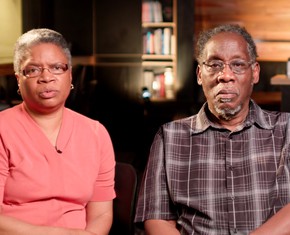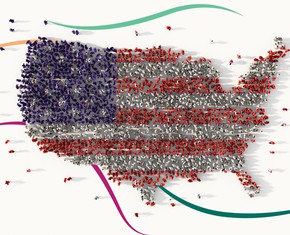The views expressed in our content reflect individual perspectives and do not represent the authoritative views of the Baha'i Faith.
In 1989, Kimberlé Crenshaw, a young member of the Law faculty at UCLA, organized the very first formal meeting on Critical Race Theory, entitled “New Developments in Critical Race Theory.” In doing so, she pulled together and labeled scholarly work that had been developing since the mid-1970s.
Much has been written in the popular media about Critical Race Theory, and multiple criticisms of it pivot on several issues that might concern those guided by the principles of the Baha’i Faith.
RELATED: The Origins of Critical Race Theory and Its Spiritual Implications
Many critics claim that advocating for Critical Race Theory represents a type of “propaganda” that seeks to attack American or “Western values.” Others have claimed that it leads to division, victimhood, and a type of unhealthy recrimination of individuals based solely on their race. Even more concerning, some have claimed that the very tools of rationality and science have been rejected in favor of purely subjective emotional storytelling.
However, these views may misunderstand what Critical Race Theory really is. Critical Race Theory represents a formal practice of inquiry rather than a set of conclusions. It offers a method of analyzing systemic racism in light of economics, culture, law, language, and history, among other disciplines. In doing so, CRT uses many techniques developed by its predecessor Critical Theory, by post-colonial theory, and by post-structuralism. Thus, the widespread claim that Critical Race Theory represents a cohesive and single conclusion about how racism functions in a society misunderstands its very nature.
Defining Critical Race Theory
While Critical Race Theory does lack a uniform message, several important themes have emerged over the years. Some of them are simply statements of what amounts to clear scientific fact: for example, that race is a social construct and not a biological fact.
Other themes require some explanation and context to understand. For example, the idea that racism is “normalized” might be easily misunderstood. However, a bit of reflection explains this conclusion: if racism is indeed a social construct, then by definition it arises out of our society and culture, so the fact that it has endured and replicated for over 400 years in the Americas means that it must be sustained by our culture and thus is accepted as “normal.” It should not be understood that “normal” implies “unchanging,” or that our society cannot deconstruct it — only that it is currently a deep part of our culture. Part of what Critical Race Theory concerns itself with is uncovering the aspects of our culture that embed and sustain the social construct of race.
In his article for the The Journal of Baha’i Studies titled “Race and Racism: Perspectives from Baha’i Theology and Critical Sociology,” sociologist Matthew Hughey traces the very origin of the word “race” as we understand it today. He demonstrates that it only appeared around the time of the so-called “Western Age of Exploration,” and shows how by the 18th century, racism became justified in scientific circles using the specious theories current at the time. He goes on to show how “Abdu’l-Baha makes it clear that the concept of ‘races’ is based on subjective and artificial categories rather than objectively extant types.”
Hughey argues that this view echoes an analysis by Shoghi Effendi, the Guardian of the Baha’i Faith from 1921 to his passing in 1957. In an open letter to the American Baha’i community entitled “The Advent of Divine Justice,” he explored at length the “corrosion of racial prejudice,” which he regarded as the “most challenging issue” attacking the “whole social structure of American society.” He viewed this problem as an issue that required “an urgency and importance that cannot be overestimated.”
One way the social construct of race has become embedded in our culture is through the power of narratives that loom large in any culture. Thus, some academics have argued that racism as a social construct exists as a story or narrative generated back in the 1600s to justify the perpetual enslavement of Black people, through the concept of white supremacy that characterized Black people as subhuman. This narrative infused every aspect of American culture, and while it has no doubt evolved, significant aspects of it still inform contemporary culture. One important way to combat this is by developing new stories or counter-narratives that challenge the ideology of white supremacy.
Critical Race Theory For Unity
Despite the fact that race is a social construct, the only approach to address it requires acknowledging the power and existence of race as a sociological force. Thus, so-called “colorblind” policies cannot address the issues racism creates. In his famous dissenting opinion in the Bakke case, Justice Blackmun argued that “to get beyond racism, we must first take account of race. There is no other way. And in order to treat some persons equally, we must treat them differently.”
This is somewhat similar to how Shoghi Effendi acknowledged race and the need to nurture and safeguard minorities. In The Advent of Divine Justice, he expressed a concept that bears great resemblance to today’s understanding of Affirmative Action:
If any discrimination is at all to be tolerated, it should be a discrimination not against, but rather in favor of the minority, be it racial or otherwise. Unlike the nations and peoples of the earth, be they of the East or of the West, democratic or authoritarian, communist or capitalist, whether belonging to the Old World or the New, who either ignore, trample upon, or extirpate, the racial, religious, or political minorities within the sphere of their jurisdiction, every organized community enlisted under the banner of Baha’u’llah should feel it to be its first and inescapable obligation to nurture, encourage, and safeguard every minority belonging to any faith, race, class, or nation within it.
In the next paragraph, he delineated how in Baha’i administrative elections, any tie should be decided in favor of the minority, and how people of underrepresented cultures should be included in key decision-making roles. He went on to quote Abdu’l-Baha’s call for unity in diversity, saying: “‘The diversity in the human family … should be the cause of love and harmony, as it is in music where many different notes blend together in the making of a perfect chord.’” Thus, Shoghi Effendi clarified that this unity was not one of colorblindness and uniformity, but a celebration of diversity.
Does Critical Race Theory Deny Rationality?
Finally, in discussions of Critical Race Theory some misunderstanding has arisen about what it means to “question the conclusions of rationality.” This grows out of the long-standing questioning of Enlightenment-style thinking – which involves the supposed ability to reach absolute objectivity, following a long line of philosophers and linguists who critiqued how biases, language, and culture inform and force conclusions that appear to be objective.
RELATED: The Enlightenment, Materialism, and the Loss of Meaning
This line of questioning has led many post-modernist philosophers like Foucault to maintain that the definitions and relationships of knowledge are the real source of power in a given society, and since the scientific community is in the business of defining and creating these relationships, they represent the true locus of power. Thus, Foucault famously quipped “knowledge is not made for understanding; it is made for cutting.” Yet many viewed this power of science as arbitrary, and even a source of oppression in the hands of the dominant class.
Generally, society is viewed in terms of power relationships between oppressor and oppressed, leaving little room for genuine altruism on the part of the dominant group. Thus, many post-modernists believed that dispersing any centralized locus of power would help mitigate oppression in society. As a result, much of the point of these sorts of critiques was to deconstruct and disperse all sources of unity in thought, since they were seen as the real source of centralized power in society. In other words, they rejected the existence of any overarching meta-narrative to history and social order.
This viewpoint is fundamentally at odds with the goals of the Baha’i Faith, which instead seeks to establish more points of unity among people, and lays out a clear historical narrative of the Divine acting in history to guide humanity towards the goal of unity and love. Additionally, when addressing the power imbalances and inequity in both wealth and race, Abdu’l-Baha consistently appealed to altruistic spiritual motives to help move the dominant group to remedy injustice.
As with any formal academic practice, there are both good and bad analyses that claim to use a given methodology. Assessing the merits of various applications of Critical Race Theory is beyond the scope of this essay and my own competency. However, it does seem to contribute to our understanding of how our society sustains racism.
As a Baha’i, I view Critical Race Theory as a valuable tool to help us root out racism from our culture. Cornel West, an eminent academic, describes Critical Race Theory as “the most exciting development in contemporary legal studies,” which “compels us to confront critically the most explosive issue in American civilization: the historical centrality and complicity of law in upholding white supremacy.”
















Comments
Sign in or create an account
Continue with Googleor